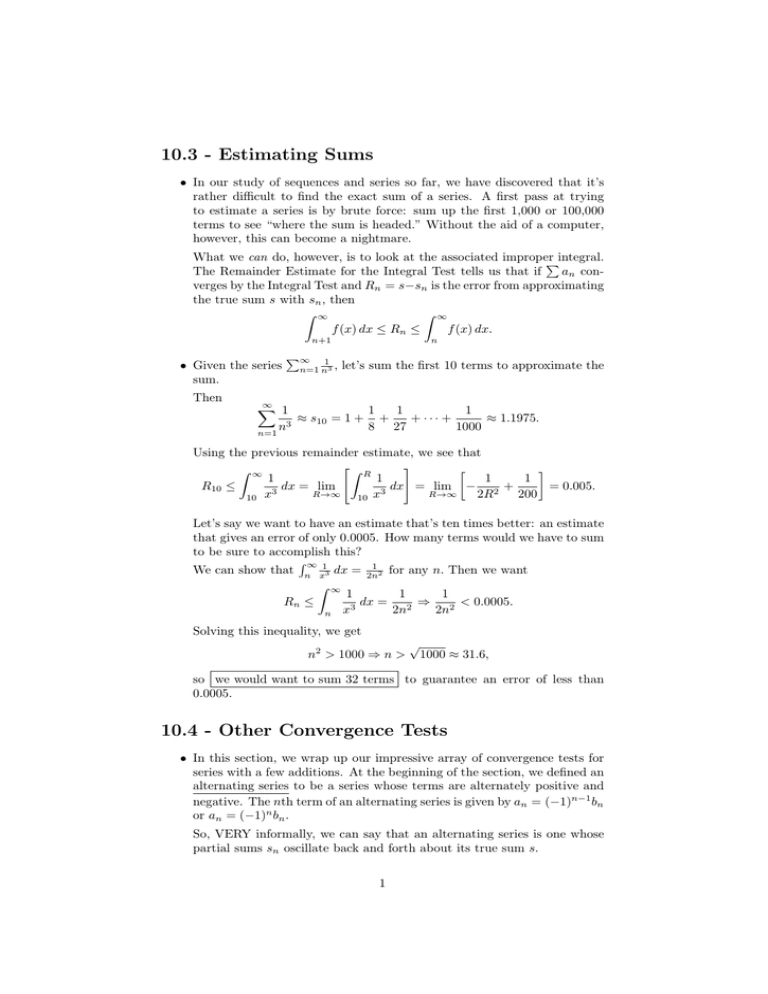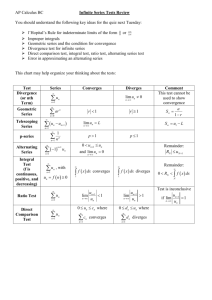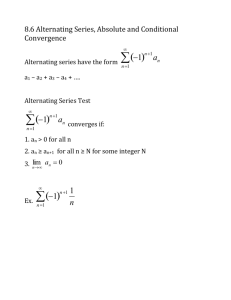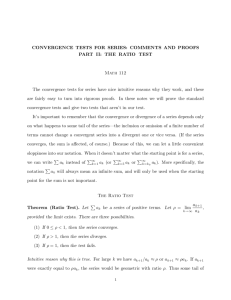10.3 - Estimating Sums
advertisement

10.3 - Estimating Sums • In our study of sequences and series so far, we have discovered that it’s rather difficult to find the exact sum of a series. A first pass at trying to estimate a series is by brute force: sum up the first 1,000 or 100,000 terms to see “where the sum is headed.” Without the aid of a computer, however, this can become a nightmare. What we can do, however, is to look at the associated improper ∑integral. The Remainder Estimate for the Integral Test tells us that if an converges by the Integral Test and Rn = s−sn is the error from approximating the true sum s with sn , then ∫ ∞ ∫ ∞ f (x) dx ≤ Rn ≤ f (x) dx. n+1 • Given the series sum. Then ∑∞ 1 n=1 n3 , n let’s sum the first 10 terms to approximate the ∞ ∑ 1 1 1 1 ≈ s10 = 1 + + + ··· + ≈ 1.1975. 3 n 8 27 1000 n=1 Using the previous remainder estimate, we see that ] [∫ ] [ ∫ ∞ R 1 1 1 1 R10 ≤ dx = lim dx = lim + = 0.005. − 3 3 R→∞ R→∞ 2R2 200 10 x 10 x Let’s say we want to have an estimate that’s ten times better: an estimate that gives an error of only 0.0005. How many terms would we have to sum to be sure to accomplish this? ∫∞ We can show that n x13 dx = 2n1 2 for any n. Then we want ∫ ∞ 1 1 1 Rn ≤ dx = 2 ⇒ 2 < 0.0005. 3 x 2n 2n n Solving this inequality, we get n2 > 1000 ⇒ n > √ 1000 ≈ 31.6, so we would want to sum 32 terms to guarantee an error of less than 0.0005. 10.4 - Other Convergence Tests • In this section, we wrap up our impressive array of convergence tests for series with a few additions. At the beginning of the section, we defined an alternating series to be a series whose terms are alternately positive and negative. The nth term of an alternating series is given by an = (−1)n−1 bn or an = (−1)n bn . So, VERY informally, we can say that an alternating series is one whose partial sums sn oscillate back and forth about its true sum s. 1 • Let’s consider the 50th partial sum s5 0 of the alternating series given by ∞ ∑ (−1)n−1 n=1 n3 . Will this partial sum be an overestimate or an underestimate of the total sum s? 49 Since (−1) is negative (we’re taking an odd power of a negative num503 ber), s50 is an underestimate of s. This can be easier seen by referring to Figure 1 on page 605 in the textbook. • Following from the notion of an alternating series was the appropriatelytitled Alternating Series Test, which stated that an alternating series of ∑ the form (−1)n−1 bn converges if the sequence bn decreases to 0. • Consider as an example the following series: ∞ ∑ (−1)n−1 n=1 np . For what values of p does this series converge? Let’s check the two conditions of the Alternating Series test: that bn is decreasing and that its limit is 0. For p ≤ 0, we see that (−1)n−1 = DNE, n→∞ np lim so the series diverges for p ≤ 0 by the Divergence Test. For p > 0, we see that 1 1 < p, (n + 1)p n so that shows that bn is decreasing. Also, lim 1 n→∞ np = 0, so, by the Alternating Series Test, this series converges for p > 0. • The last convergence test we learned about was the Ratio Test, which says that: ∑ – If limn→∞ aan+1 an is absolutely convergent (and < 1, the series n therefore convergent). ∑ an is divergent. – If limn→∞ aan+1 > 1, the series n – If limn→∞ aan+1 = 1, the Ratio Test is inconclusive. n • Let’s apply this to the following series: ∞ ∑ (n + 2)! n=1 2 n!10n . I think it’s plainly obvious that trying to integrate the related function to this, compare it to anything else, or find the limit of this would be a nightmare, so let’s try the Ratio Test. The Ratio Test turns out to be a good idea for many series that involve factorials and powers of n. Let’s then consider ) ( an+1 n+3 1 (n + 3)! n!10n 1 lim lim = < 1, = lim · = n→∞ an n→∞ (n + 1)!10n+1 (n + 2)! 10 n→∞ n + 1 10 so the series is absolutely convergent (and thus convergent) by the Ratio Test. 10.5 - Power Series • A power series is a series of the form ∞ ∑ cn xn = c0 + c1 x + c2 x2 + · · · , n=1 where x is a variable and the cn ’s are constants called the coefficients of the series. We get a power series centered at x = a if we replace x by (x − a). ∑∞ We discovered in this section that, for a given power series n=0 cn (x−a)n , there are only three possibilities: – The series converges only when x = a. – The series converges for all x. – There is a positive number R (known as the radius of convergence) such that the series converges if |x−a| < R and diverges if |x−a| > R. ∑∞ n • Suppose, then, that we know n=0 cn x converges when x = −4 and diverges when x = 6. We then know that the radius of convergence R of this series is in the range 4 < R < 6, although we can’t know exactly what it is. This implies that the series certainly converges for x ∈ (−4, 4), that it might converge for x ∈ (−6, 6), and that it certainly doesn’t converge for |x| ≥ 6. Given this information, we can discover a few things about related series: ∑∞ – The series n=1 cn converges since x = 1 here and 1 lies in the interval (−4, 4). ∑∞ – The series n=1 cn 8n diverges since 8 is not in the interval (−6, 6). ∑∞ – The series n=1 cn (−3)n converges since −3 is in the interval (−4, 4). ∑∞ – The series n=1(−1)n cn 9n diverges since neither 9 nor −9 is in the interval (−4, 4). 3 • To determine the radius of convergence R of a power series, we apply the Ratio Test and see which values of x guarantee convergence. For example, consider the series ∞ ∑ (x − 4)n . n5n n=1 Applying the Ratio Test to this series: ( ) n+1 an+1 | n 1 n5n 1 = lim |(x − 4) = |x−4|. lim · = |x−4| lim n→∞ (n + 1)5n+1 |(x − 4)n | n→∞ n + 1 n→∞ an 5 5 By the Ratio Test, we want this quantity to be less than 1 for convergence, so 1 |x − 4| < 1 ⇒ |x − 4| < 5 ⇒ −5 < x − 4 < 5 ⇒ −1 < x < 9. 5 From this, we see that the radius of convergence is R = 5 and the interval of convergence is −1 < x < 9. 4




